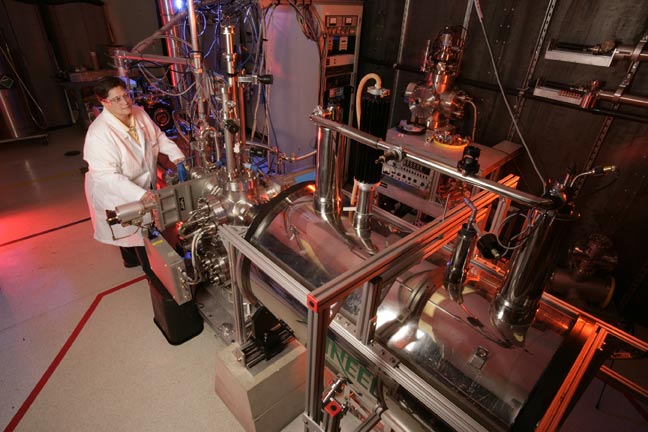How NASA Might Find Rock-Eating Microbes on Mars

Signs of life on Mars may be hiding under its rocks, orperhaps hiding inside those rocks. A new study offers a simplifiedtechnique for detecting biological and pre-biotic molecules that become trappedinside minerals.
Studying seven samples of the mineraljarosite collected from various places on Earth, a group of researchers wasable to identify amino acids, the basic components of proteins, that hadpresumably been incorporated into the mineral's crystal structure.
Although not the first time biological compounds have beendetected inside rock, the new method has the advantage that it works "atvery low concentration without prior sample preparation," said NancyHinman of the University of Montana.
Hinman and her colleagues believe their technique would beperfect for looking at martian samples brought back from a future mission.
Minerals and microbes
Jarosite is a yellowish-brown sulfate mineral containingiron, potassium and hydroxide. It is found in places around the world such assouthern California beaches and volcanic fields in New Zealand. It forms onlyin the presence of highly acidic water.
In 2004, jarositewas discovered on Mars by Opportunity, one of NASA's Mars ExplorationRovers. Scientists immediately heralded it as clear evidence for past wateron the red planet.
Get the Space.com Newsletter
Breaking space news, the latest updates on rocket launches, skywatching events and more!
But there is something else about jarosite that makes itinteresting. One of the steps in its formation involves combining pyrite(ferrous sulfide) with oxygen. This oxidation reaction can be performed bycertain "rock-eating" microorganisms.
"The rate of the jarosite formation would be extremelyslow without microbes and the presence of water," Hinman said.
Whether jarosite can form without the assistance of thesemicrobes is very difficult to say, since every corner of Earth is occupied bylittle bugs of some sort or another.
"I don't know of any environment devoid ofmicroorganisms," Hinman said. "Earth is not a good test bed forabiotic processes."
But perhaps Mars is. There are theories for how jarositemight form in the absence of life.
"It's a very oxidizingenvironment on Mars," explained co-author Michelle Kotler, also fromthe University of Montana. Jarosite could therefore arise from chemicalweathering of the planet's abundant basalt rocks.
Garbage can
And yet, there remains the tantalizing possibility thatmartian jarosite owes its existence to the martian version of rock-eatingmicrobes. If so, remnants of these organisms may be locked in the mineral.
This is because jarosite on Earth is known to let all sortsof foreign elements incorporate into its crystal structure.
"It's a bit of a garbage can mineral," Hinmansaid.
Among the foreign substances are organic compounds. However,previous techniques for detecting them required that the jarosite be dissolvedin a solution or mixed in with some other medium, which dilutes the sample andruns the risk of introducing contamination.
"We are very concerned about contamination,"Hinman said.
Hinman and her colleagues have a technique that requires nosample preparation. They use a laser-based optical and chemical imager (LOCI),located in co-author Jill Scott's lab at the Idaho National Laboratory. Asingle laser shot vaporizes a small portion of the crystal surface intoindividual ions. These pass through a mass spectrometer, which can identifyeach ion by how much mass and charge it has.
In four of the seven samples, the scientists detectedglycine, the smallest of the amino acids required for making proteins.
Sample return
"This study shows that a molecule basic to life can bedetected in an important martian mineral using an instrument that might fly ona future spacecraft," said Carlton Allen, Astromaterials Curator at NASAJohnson Space Center.
But the method probably will not be suitable for anynear-term missions because of the mass and complexity of the LOCI instrument,said David Beaty, chief scientist of the Mars Exploration Directorate at theJet Propulsion Laboratory.
Instead, the technique could be used for samplereturn missions that NASA researchers are currently planning for.
"The advantage of our method is that it doesn't needsample preparation," Kotler said. "We just put the rock in themachine and shoot it."
Not only can their technique identify organics, but it canalso measure the isotope ratios of carbon and other elements. If the accuracycan be improved, this measurement could potentially tell researchers whetherthe organic molecules they find came from living things or not.
"There's an advantage for organisms to use the lighterisotopes," Kotler explained. This shows up, for example, as a higherpercentage of the isotope carbon-12 versus carbon-13 in biological samples.
Although jarosite possibly may have provided martianbiomolecules safe haven from the planet's harsh UV radiation, astrobiologists areinterested in studying a whole list of martian minerals.
"One thing that is becoming clear is that the totalscientific return on [a samplereturn] mission would be dependent on the diversity of the samplecollection, and it is important to plan for ways to optimize thatdiversity," Beaty said.
Join our Space Forums to keep talking space on the latest missions, night sky and more! And if you have a news tip, correction or comment, let us know at: community@space.com.

Michael Schirber is a freelance writer based in Lyons, France who began writing for Space.com and Live Science in 2004 . He's covered a wide range of topics for Space.com and Live Science, from the origin of life to the physics of NASCAR driving. He also authored a long series of articles about environmental technology. Michael earned a Ph.D. in astrophysics from Ohio State University while studying quasars and the ultraviolet background. Over the years, Michael has also written for Science, Physics World, and New Scientist, most recently as a corresponding editor for Physics.









